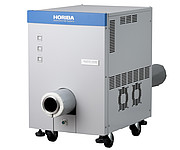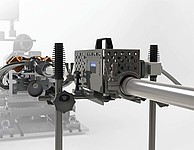

Heavy duty vehicles (HDVs) have been recognised the world over as significant contributors to air pollution and, in Europe, emissions testing for HDV diesel engines started in 1992 under EURO I. The current regulation is EURO VI (introduced in 2013) and we are presently at Step D - which includes In-Service Conformity (ISC) using Portable Emissions Measurements Systems (PEMS). Also, evolving Real Driving Emissions (RDE) are expected to move away from the current format of tests and become more ‘real world’.
An HDV on-road testing evolution is about to happen. Are you ready?
The EURO VI standards apply to all engine types and comprises:
Bus Exhaust Emissions
EURO VI includes tough emissions limits for total hydrocarbons (THC), nitrogen oxides (NOx) and carbon monoxide (CO) gases plus Particulate Matter (PM) and Particle Number (PN). For ISC, all these emissions (except PN) have a current conformity (CF) factor of 1 + 0.5, allowing for ISC emissions in the field to be measured at up to 50% more than the applicable limits. Laboratory emissions limits are also in place for ammonia, with an average concentration limit of 10 ppm.
On Board ISC for PN has now been included under Step E and will have an initial CF of 1 + 0.63 when it comes into force.
Carbon dioxide (CO2) emissions levels are currently not included in any limits, though there are mandatory reductions required over the next ten years.
Also, current ‘boundary condition’ road tests are simply a means of determining the emissions of vehicles under similar conditions which, realistically, may not be encountered often during the vehicles’ service lives. Going ‘real world’ will entail test conditions such as cold starts (which is already the case for the incoming EURO VI Step E – i.e. the test starts and data evaluation begins at engine-start), and extended urban stop-start driving in the future.
Other changes likely to happen in the next few years include:
Help is at hand, for more information on HORIBA's solutions.
As OEMs of Heavy-Duty Vehicles (HDVs) you will already be familiar with emissions testing and aware that test limits are becoming more stringent.
The biggest challenges you face are in relation to changing test parameters and the likely addition of new emissions to be tested as part of type approval. Break it down though and it is all about data.
Heavy Duty Vehicle Testing
Working closely with regulatory authorities, and active on many working groups, HORIBA has a comprehensive understanding of how the industry is changing under ISC for HDVs.
HORIBA have been active in the combustion engine emissions measurement and analysis industry since the 1960s and have grouped together a selection of solutions to help you capture the data you need to make informed decisions during your R&D work, that will save you time and money through fewer prototypes, for example, and reduce your project risks.
Imagine having the world leader in emissions measurement by your side during these challenging times.

A versatile PEMS for engine monitoring under real world operating conditions. The OBS-ONE measures concentrations of emissions (CO, CO2, THC, NOx, NO2), PN, PM, air-to-fuel ratio, exhaust flow rate, GPS data, environmental conditions (atmospheric temperature, humidity and pressure) and calculates mass emissions.
These include:
This product is RDE+ Compatible
HORIBA’s RDE+ is an all-encompassing solution that comprises proven, robust and integrated processes and tools to support your design, development, validation and verification activities

A system that protects the OBS-ONE from harmful shocks and vibrations and which allows accurate emissions measurements in the harshest of environments. The RE also has a WiFi feature to allow remote monitoring and control – which allows the NRMM driver to concentrate on its operation.
These include:
This product is RDE+ Compatible
HORIBA’s RDE+ is an all-encompassing solution that comprises proven, robust and integrated processes and tools to support your design, development, validation and verification activities

EXFM-ONE employs an ultrasonic method for measuring exhaust gas flow rates directly from a vehicle or engine. The unit can be used for various applications such as real time mass measurement of raw exhaust gas.
These include:
Note: The EXFM-ONE may not be suitable for all HDV exhaust gas flow tests as its maximum flow rate is 10m3/min and the gas temperature limits are 300°C (continuous) and up to 370°C for short bursts.

The Pitot Tube Flow Meter, PTFM-1000V2 is a standalone device for measuring the exhaust gas flow rate of a combustion engine. The system uses the tried-and-tested pitot tube principle with high-frequency transducers that ensures pulsations are not missed.
These include:
This product is RDE+ Compatible
HORIBA’s RDE+ is an all-encompassing solution that comprises proven, robust and integrated processes and tools to support your design, development, validation and verification activities

The standalone Dual Pitot Tube Flow Meter, PTFM-ONE DT is used for the measurement of engine exhaust gas flow rates for engine and chassis dyno tests. It consists of a tailpipe attached with two pitot tubes and an interface all housed in a single chassis.
These include:
Note: The PTFM-ONE-DT may not be suitable for all HDV exhaust gas flow tests as its maximum flow rate is 14.5m3/min.
This product is RDE+ Compatible
HORIBA’s RDE+ is an all-encompassing solution that comprises proven, robust and integrated processes and tools to support your design, development, validation and verification activities
Do you have any questions or requests? Use this form to contact our specialists.
